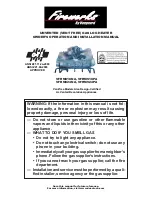
Installation 5
uniSTOR GB
9
5 Installation
5.1 Installation requirements
5.1.1 Siting
Locate the uniSTOR in the building in the most
convenient position ensuring that:
– The discharge pipe from the tundish can be installed
with a minimum fall of 1:200 and must be terminated
in a safe and visible position (see section 4.1.4
Discharge pipework).
– The base chosen for the unit is level and capable of
supporting the weight of the cylinder when full
(see section 8: Technical Data).
– The installation site is frost-free. If necessary provide
a frost protection thermostat.
– Access is available for user operation of the DHW
temperature control under the front panel.
– Suitable clearances exist to allow installation, checking
and repressurising of the expansion vessel.
– The installation site chosen does not result in
excessive ”dead leg” distances, particularly to the
point of most frequent use.
– A suitable cold mains water supply pipe can be
provided to the uniSTOR direct from the main water
stop valve of the building.
5.1.2 Mains Water Pressure
The DHW performance of an unvented cylinder
installation will correspond to the available mains water
supply pressure and flow rate. To achieve optimum
performance from the uniSTOR a suitable cold mains
water supply must be available, i. e. the measured static
pressure from the incoming mains water supply should
be at least 2.0 bar. A corresponding flow rate at least
20-25 l/min should be available.
Note:
Mains water pressures will reduce during periods
of peak demand. Ensure that measurements are
taken during these periods.
Example:
If the measured cold mains supply pressure is 2 bar
static and the cold mains flow rate available is 30 l/min,
the available flow rate of mixed water at 40 °C will be
25 l/min (from 15 l/min hot water from the uniSTOR at
60 °C together with 10 l/min cold water at 10°C).
The uniSTOR will operate satisfactorily with water
supply pressures below 2 bar although flow rates will be
reduced. If the supply pressure is below 1 bar the
uniSTOR unvented storage cylinder should not be
installed. Contact Vaillant Ltd. for details on alternative
hot water supply systems.
In order to minimise frictional losses minimum 22 mm
bore is recommended for new cold mains supply
pipework into the dwelling although satisfactory
performance can be achieved with 15 mm bore pipework.
5.1.3 Pipework – Primary Circuit
The primary circuit pipework between the Vaillant boiler
and the uniSTOR should be installed using copper tube
of minimum size 22 mm.
If the distance between the boiler and the cylinder is
excessive, a larger pipe diameter may be necessary. It is
not necessary to install a circulating pump in this
pipework because all Vaillant wall mounted boilers
contain a built-in circulating pump (except ecoMAX pro
open-vented boilers).
If the uniSTOR cylinder will be used with any other UK
Standard boiler a suitable pump must be fitted into the
primary circuit.
5.1.4 Discharge Pipework
The outlet connections of both the temperature and
pressure relief valve and expansion relief valve should be
connected in 15 mm copper tube to the tundish supplied.
The tundish should be installed vertically, as close to the
uniSTOR as possible and within 500 mm of the
temperature and pressure relief outlet. It must be
positioned away from any electrical components and
installed in the same space as the uniSTOR cylinder, so
that it is visible to the user.
The D1 discharge pipe from the T&P Valve/Expansion
valve can be teed together upstream of the tundish (see
fig 6). The discharge pipework must be installed using
minimum 22 mm copper pipework from the 22 mm
connection on the tundish to a safe and visible discharge
point. There must be a vertical section of pipe at least
300 mm long, below the tundish before any bends or
elbows in the pipework. Increase the diameter of the
pipework if the total resistance of the discharge
pipework exceeds the figures shown in the table below.
The installation of the discharge pipework must be in
accordance with G3 (see fig. 2).
Minimum size
Maximum total resistance
Resistance created
of discharge
allowed expressed as a
by each elbow
pipework
length of straight pipe
or bend
from Tundish
(i. e. no elbows or bends)
22 mm
up to 9 m
0.8 m
28 mm
up to 18 mm
1.0 m
35 mm
up to 27 mm
1.4 m










































